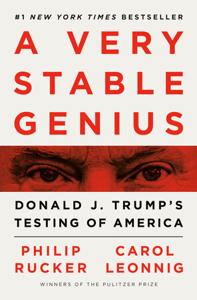
Want to learn the ideas in A Very Stable Genius better than ever? Read the world’s #1 book summary of A Very Stable Genius by Philip Rucker, Carol Leonnig here.
Read a brief 1-Page Summary or watch video summaries curated by our expert team. Note: this book guide is not affiliated with or endorsed by the publisher or author, and we always encourage you to purchase and read the full book.
Video Summaries of A Very Stable Genius
We’ve scoured the Internet for the very best videos on A Very Stable Genius, from high-quality videos summaries to interviews or commentary by Philip Rucker, Carol Leonnig.
1-Page Summary of A Very Stable Genius
Overview
In July 2016, Donald J. Trump gave a speech accepting the Republican party nomination to run for the presidency of the United States. This was a foretaste of what was to come in his campaign trail and later on as president.
Previous presidents have used the Inaugural Address to emphasize unity and common purpose. They had been humble, extolled shared values, and spoken of “we” and “us.” Trump’s speech was different. It was brash and bombastic. Most importantly, it focused on himself rather than others.
President Trump said, “I am your voice” and that he will be a champion for the people. He also stated that nobody knows the system better than him, so he can fix it. Since then, we have witnessed his presidency fueled by solipsism—an extraordinary one-man show with seemingly chaotic moments. It’s been a dizzying journey to keep up with everything going on in Washington D.C., which is why Carol Leonig and Philip Rucker decided to take stock of Trump’s first three years in office and figure out what was really going on behind the scenes during this time period.
We will be exploring the controversies and defining moments of Trump’s presidency so far. Along the way, you will learn what foreign leaders think about him and how his abusive behavior has affected his subordinates.
Big Idea #1: An outburst early on in Trump’s presidency alienated the US military’s top brass.
On a hot July day in 2017, Donald Trump attended a meeting at the Pentagon. The room was called “the Tank” and it had no windows so that confidential discussions could be held there. It’s where America’s top military leaders meet to discuss national security issues, but on this day they were focused on educating the new President about those issues. They were surprised by what he said during that meeting.
The message here is that Trump had alienated the military’s top brass early on. The president lacked attention span and officials realized this as soon as he took office. Therefore, when they sat down with him in the Tank, Tillerson and Mattis knew it would be a challenge to get his attention.
In order to keep the president focused, his advisors created a presentation with plenty of graphics and maps. The two men tried to convince Trump that America’s safety is dependent on overseas commitments and alliances like NATO.
Trump was angry. He didn’t like being lectured by his advisers, and he also objected to their internationalist language. NATO is worthless, Trump said at first. The so-called allies are freeloaders living off America’s money. We’re owed a lot of money, Trump told them angrily, and you aren’t collecting it from the countries that owe us billions of dollars in oil payments for protecting them with our military bases in the Middle East.
General Mattis argued that the purpose of these alliances and military bases was to protect America’s interests. However, President Trump didn’t agree with him. He asked why we haven’t won the war in Afghanistan? The president answered himself by saying it was a “loser war.”
By this point, he was very angry. He said something that made the room go silent. Later, when the meeting had ended and Trump left, Tillerson called him a moron (a word used to describe someone who is not intelligent).
Big Idea #2: Time and again, Trump demonstrates ignorance of subjects presidents have traditionally been expected to know.
In order to contain China, Trump’s secretary of state wanted to strengthen America’s relationship with India. To kickstart the process, he arranged for Trump and Modi to meet each other.
When Modi brought up China’s aggression, Trump cut him off and told him not to worry about it. He then stated that India didn’t have a border with China. This made Modi realize that Trump couldn’t be trusted to protect Indian interests. The plan was dead before it even began.





